Eastern
Hospital
Homerton Grove, E9 6BY
Medical
dates:
Medical
character:
Infectious diseases.
Later, also TB, geriatric, neurological (rehabilitation) and mental handicap.
In 1867 one of the
responsibilities of the newly formed Metropolitan
Asylums Board
(MAB) was the care and control of all pauper cases of fever and
smallpox in London. To this end, MAB began a programme of
building infectious diseases hospitals.
Early in 1868 MAB purchased land north of The Grove, Homerton, directly adjacent to the East London Union workhouse. The site, just under 8 acres, had cost £11,812 and was to be used for a paired fever and smallpox hospital for northeast London.
The Homerton Fever Hospital, at the north of the site, opened first, in December 1870. It had 200 beds, which were immediately filled with cases of 'relapsing fever' (a disease similar to typhus, but caused by the spirochaete Borrelia recurrentis). Building work continued on the adjacent smallpox hospital (a smallpox epidemic seemed imminent as the number of cases were increasing) and this opened on 26th February 1871, a month after its sister hospital, the South Western Smallpox Hospital in Stockwell.
The Fever Hospital had cost £27,320 to build. The pavilion blocks contained six wards of 18 beds each for typhus patients, two wards of 18 beds each for those with scarlet fever, two wards of 24 beds each for enteric fever cases and two 4-bedded wards for special cases (one for male and one for female patients).
The Homerton Smallpox Hospital, built at a cost of £19,964, contained 102 beds in four pavilion blocks. There were eight wards with 12 beds each and 2 special wards - one for 3 male and one for 3 female patients. As with other infectious diseases hospitals, each bed space for typhus, scarlet fever and smallpox cases was allocated 2,000 cubic feet (67 cubic metres) or 1,633 cubic feet (54 cubic metres) for enteric fever.
Within a few days of opening at the end of February 1871 the Smallpox Hospital had been filled and the Fever Hospital had to be appropriated. It was also soon filled. As the epidemic increased, more beds were placed in the wards, while convalescent patients were housed in the corridors, then in tents erected in the grounds. The average length of stay for a patient was 51 days. By June 1871 the Fever Hospital contained 284 smallpox cases and the Smallpox Hospital 152. By July the epidemic was abating and the use of the Fever Hospital for smallpox cases was discontinued. It was cleaned and disinfected and reopened as a Fever Hospital. The Hospital then received fever patients from all over London until the end of June 1872, when the South Western Fever Hospital (which was being used for smallpox patients) reverted to its proper role. During this time some 3,390 patients had been admitted - 378 with simple continued fever, 528 with typhus, 884 with enteric fever, 1,042 with scarlet fever and 558 with other diseases (measles, chickenpox, pneumonia, rheumatism, TB, etc). Of these, 601 had died.
The Smallpox Hospital continued to receive a large number of smallpox cases until the midsummer of 1872. By October 1873 it was almost empty. The wards were cleaned, disinfected and repainted. During the epidemic some 4,372 cases had been admitted, of which 811 had died (608 of these had been unvaccinated) - a mortality rate of 18.5%. Unvaccinated smallpox patients had a far higher mortality rate - 35.5% - compared to 7.6% of vaccinated patients.
Patients' visitors were limited to the nearest relatives and intimate friends; they were warned that they ran a great risk in entering the Hospitals. Those visiting smallpox patients were advised to be revaccinated and to eat before entering. They were instructed to sit on a chair at some little distance from the bed and to avoid touching the patient (especially any emanations from their skin) or their bedclothes and to avoid exposure to the patient's breath. The Smallpox Hospital provided wrappers for visitors to wear over their clothes. Visitors were advised to wash their faces and hands in carbolic soap and water before leaving the Hospital, and not to use public transport to get home.
In 1873 four fever wards with 120 beds were set aside as a cholera outbreak was feared, but the event did not happen and they were not needed.
By October 1874 the Smallpox Hospital was being used as an auxiliary fever hospital for overspill scarlet fever cases from the Fever Hospital. Some 1,226 cases were admitted during the year, of whom 199 died (a mortality rate of 16%). Of the 15 nurses and servants who contracted typhus, one died.
In 1875 the average daily cost of an in-patient in both Hospitals (which was charged to the patient's parish) was about 1 shilling 3d (about 6p), including provision, clothing and medications. During the year, some 1,126 fever cases had been admitted, of whom 159 died (a mortality rate of 14%).
In 1876, while the Smallpox Hospital was vacant, the administration block was enlarged. New commodious offices were built for the Medical Superintendent and the Steward adjoining newly enlarged storerooms, with dormitory rooms above for male servants. Two new mortuaries were erected, one for each of the Hospitals. The grounds were improved, trees were planted and the roads resurfaced. The average daily cost for an in-patient with fever had risen to 1s 6d (7p) and 1s 8d (8p) for a smallpox patient.
Later in 1876 another smallpox epidemic began. The Smallpox Hospital was again being used for scarlet fever cases from all over London, so smallpox patients were sent to the South-Western Hospital. The Smallpox Hospital finally reopened in August with 86 cases (the infection was especially virulent in Islington). By October the numbers of beds had had to be increased to 140. In November convalescent patients were transferred to other hospitals, but the epidemic continued. When 157 patients had been admitted, MAB tried to find other accommodation, but the London Fever Hospital in Islington refused to take any more cases. The Fever Hospital was filled with patients, but the Hospital Committee reluctantly agreed to parts of the Hospital being used for smallpox cases. The South-Western Hospital accepted a large number of fever cases, while the remainder were housed in the pavilions furthest away from the smallpox wards. After five days of preparation, 151 smallpox patients were moved to the Fever Hospital, while two wooden huts were built in the grounds for acute and convalescent smallpox patients. Fortunately, there was no cross-infection between the fever and the smallpox patients.
By the end of July 1878 the epidemic had abated and the Smallpox Hospital was closed. The kitchen was enlarged, as was the laundry, which was too small and ill-arranged. Internal repairs and cleaning were carried out in the wards.
By October 1878 the Fever Hospital was admitting increasingly large numbers of scarlet fever patients. The typhus wards had to be used for them and the bed accommodation was increased from 200 to 240 by the use of the wooden huts. By the end of the year 1,048 patients had been received, of whom 140 had died (a mortality rate of 13%).
In January 1879 the Smallpox Hospital was being used for convalescent enteric fever cases from the Fever Hospital. By October it was full. The daily in-patient costs were 1s 4d (7p). By the end of the year, some 937 cases had been admitted to the Fever Hospital, of whom 139 had died (a mortality rate of 15%). Cases of smallpox had been sent to the South-Eastern Hospital in Deptford.
At the beginning of 1880 both Hospitals were again being used for fever cases. The Smallpox Hospital reopened in February as smallpox cases began to increase. By October a new epidemic was well underway and by December the Smallpox Hospital was full. Convalescent smallpox patients were sent to other hospitals. Some 860 cases had been admitted, but 11 of these were infected babies being breastfed by their unaffected mothers, 4 were unaffected babies whose mothers had smallpox and 12 had some other eruptive disease.
At the same time an outbreak of scarlet fever required the number of beds in the Fever Hospital to be increased from 200 to 250. Some 1,061 patients were admitted, of whom 124 died (a mortality rate of 12%).
In 1881 both Hospitals were being used for their declared purposes, but then the Fever Hospital again had to be used for smallpox patients. A large portion - some 180 beds - was appropriated for smallpox cases, while fever patients were sent to the South-Western Fever Hospital in Stockwell. Smallpox patients were admitted at the rate of 30 a day. By mid May any fever patients were housed in the wooden huts, while the wards were filled with smallpox cases. From May to July, 749 cases of smallpox were admitted to the smallpox wards of the Fever Hospital (42 of these turned out to have other diseases); 115 died (a mortality rate of 15%). The Fever Hospital reopened for fever patients in August, after thorough cleaning and disinfection. From May to September, 595 smallpox cases were treated at the Smallpox Hospital; 84 died (a mortality rate of 14.1%). In October the Smallpox Hospital was disinfected and used for fever patients. Smallpox cases were sent to the Atlas hospital ship, but those too ill to travel were housed in two wards in the Fever Hospital. During 1881 some 978 fever patients had been admitted, of whom 152 had died (a mortality rate of 15,5%), and some 2,304 smallpox patients, of whom 365 had died (a mortality rate of 16%).
In the first ten years of the Fever Hospital's existence, some 9,091 patients had been admitted, of whom 1,517 had died (a mortality rate of 16.68%).
At the end of 1881 the laundry at the Fever Hospital was enlarged and re-equipped with new apparatus. A new boiler house was built and a new boiler installed. The height of the boundary wall was increased and the entrance gate to the Hospitals improved, enabling the more speedy entrance of ambulances.
Up to this time patients had been brought to the Hospitals in any available vehicle, most of them unsuitable as they did not allow the patient to lie down. Since the drivers were not MAB employees, they were undisciplined and not averse to stopping along the way for a drink in a public house, leaving the patient unattended unless accompanied by a relative. In 1881 MAB acquired an ambulance station in London Fields. The horse-drawn ambulances were fitted with an air bed, pillows and blankets; hot water bottles and stimulants were provided. An experienced nurse travelled with the patient from home to hospital (and a male attendant if the patient was very ill). Friends or relatives were not permitted to accompany the patient in the ambulance. The drivers wore a uniform, which was not allowed to be worn off duty (on pain of dismissal) and were not permitted to stop at public houses. After each journey the ambulance was washed and disinfected.
In 1882 some 40 beds in the Fever Hospital were reserved for severe smallpox cases. During the year 1,343 fever patients were treated, of whom 195 had died (a mortality rate of 14.5%). In the smallpox wards 192 were treated, of whom 31 had died (a mortality rate of 16%).
A Royal Commission, which had been established in 1881 to investigate the prevailing agitation over the location of smallpox hospitals, concluded that smallpox patients should not be kept in urban areas but transferred instead to hospitals in isolated regions. From 1883 all smallpox patients were to be sent to smallpox ships moored outside London.
In 1883 the Homerton Hospitals were renamed the Eastern District Fever and the Eastern District Smallpox Hospitals. By 1884 the word 'District' had been dropped, and they both were known simply as the Eastern Fever Hospital.
In 1885 an ambulance station was built off Brooksby Walk.
During 1887 some 1,907 fever cases had been admitted; 46 nurses and servants had contracted infectious diseases in the course of their duties.
By 1900 the Hospital had 362 beds. Some 2,513 patients had been admitted during the year: 367 with scarlet fever (8% mortality), 1,633 with diphtheria (14% mortality) and 246 with enteric fever, of whom 34 died (14% mortality). In September a new isolation block was built and held in readiness for plague cases.
In 1912 the horse-drawn ambulances were replaced by 35 motor ambulances.
In 1921, when the Hospital had 375 beds, MAB purchased the adjacent City of London Institution (the former East London Union workhouse) immediately to the west of the Hospital, which had become the City of London Military Hospital during WW1. The buildings were put into use immediately without alteration, and provided 260 extra beds, mainly for children with scarlet fever and diphtheria. Patients were nursed in isolation cubicles until the diagnosis was confirmed, and then moved to the open wards.
In 1930 MAB was abolished and the Hospital came under the control of the LCC. A new isolation block was built in 1935 and plans for a major rebuilding of the Hospital were made in 1939, but any work was postponed due to the outbreak of WW2.
During WW2 the Hospital joined the Emergency Medical Service with 462 beds. When St John's Hospital for Diseases of the Skin was bombed during WW2, its in-patients were moved to the Eastern - a relationship which continued until their closure. The Dermatological Unit had 8 wards and various ancillary rooms (and later a Professorial Unit).
In 1948 the Hospital joined the NHS as the Eastern Hospital. It was under the control of the Hackney Group Hospital Management Committee, part of the North East Metropolitan Regional Hospital Board. It had 621 beds - 511 for infectious diseases patients, with a further 110 allocated to St John's Hospital for Diseases of the Skin.
A new Out-Patients Department opened, as well as a ward for ear, nose and throat (ENT) patients, but the outbreak of polio meant that operations for the removal of tonsils and adenoids had to be suspended.
In 1950 a 16-bedded ward was opened for TB patients (whose average length of stay was 177 days). It was planned to open another two wards of the same size in 1951 following external renovation and repainting.
By the early 1950s the war damage to two wards had been repaired and considerable repairs and redecoration carried out throughout the rest of the Hospital. The occupied wards had been redecorated throughout, as well as the laundry, the kitchen and a major portion of the Nurses' Homes (where 300 staff, also from other hospitals in the Group, lived).
In 1953, during a time of severe staff shortage, the Hospital had 545 beds for patients with infectious diseases and two wards with 36 beds for TB patients. St John's Hospital for Diseases of the Skin had 51 beds.
By the mid 1950s the two TB wards had closed and the space was used for 40 beds for geriatric patients. A temporary unit was established for patients with bulbar polio.
In 1958 the Hospital again had 621 beds, including the 110 used by St John's Hospital for Diseases of the Skin.
In 1963 a Regional Neurological Unit with 21 beds opened as a rehabilitation unit. By 1966 the Hospital had 495 beds for infectious diseases patients, geriatric patients, neurological patients undergoing rehabilitation and for severely mentally handicapped children.
In 1974, following a major reorganisation of the NHS, the Hospital came under the control of the City and East London (Teaching) Area Health Authority, part of the North East Thames Regional Health Authority. It had 336 beds, excluding the 110 occupied by St John's Hospital for Diseases of the Skin.
After another NHS reorganisation, in 1983 the Hospital came under the control of the City and Hackney District Health Authority. It had 287 (excluding the St John's Hospital ones) and was being used mainly for the rehabilitation of elderly neurological patients. Plans for building a new general hospital on the same site were underway. The Hospital was gradually closed as services were transferred elsewhere. By 1984 only 23 neurorehabilitation beds remained.
The remaining beds closed when the new Homerton Hospital opened in the summer of 1986.
Early in 1868 MAB purchased land north of The Grove, Homerton, directly adjacent to the East London Union workhouse. The site, just under 8 acres, had cost £11,812 and was to be used for a paired fever and smallpox hospital for northeast London.
The Homerton Fever Hospital, at the north of the site, opened first, in December 1870. It had 200 beds, which were immediately filled with cases of 'relapsing fever' (a disease similar to typhus, but caused by the spirochaete Borrelia recurrentis). Building work continued on the adjacent smallpox hospital (a smallpox epidemic seemed imminent as the number of cases were increasing) and this opened on 26th February 1871, a month after its sister hospital, the South Western Smallpox Hospital in Stockwell.
The Fever Hospital had cost £27,320 to build. The pavilion blocks contained six wards of 18 beds each for typhus patients, two wards of 18 beds each for those with scarlet fever, two wards of 24 beds each for enteric fever cases and two 4-bedded wards for special cases (one for male and one for female patients).
The Homerton Smallpox Hospital, built at a cost of £19,964, contained 102 beds in four pavilion blocks. There were eight wards with 12 beds each and 2 special wards - one for 3 male and one for 3 female patients. As with other infectious diseases hospitals, each bed space for typhus, scarlet fever and smallpox cases was allocated 2,000 cubic feet (67 cubic metres) or 1,633 cubic feet (54 cubic metres) for enteric fever.
Within a few days of opening at the end of February 1871 the Smallpox Hospital had been filled and the Fever Hospital had to be appropriated. It was also soon filled. As the epidemic increased, more beds were placed in the wards, while convalescent patients were housed in the corridors, then in tents erected in the grounds. The average length of stay for a patient was 51 days. By June 1871 the Fever Hospital contained 284 smallpox cases and the Smallpox Hospital 152. By July the epidemic was abating and the use of the Fever Hospital for smallpox cases was discontinued. It was cleaned and disinfected and reopened as a Fever Hospital. The Hospital then received fever patients from all over London until the end of June 1872, when the South Western Fever Hospital (which was being used for smallpox patients) reverted to its proper role. During this time some 3,390 patients had been admitted - 378 with simple continued fever, 528 with typhus, 884 with enteric fever, 1,042 with scarlet fever and 558 with other diseases (measles, chickenpox, pneumonia, rheumatism, TB, etc). Of these, 601 had died.
The Smallpox Hospital continued to receive a large number of smallpox cases until the midsummer of 1872. By October 1873 it was almost empty. The wards were cleaned, disinfected and repainted. During the epidemic some 4,372 cases had been admitted, of which 811 had died (608 of these had been unvaccinated) - a mortality rate of 18.5%. Unvaccinated smallpox patients had a far higher mortality rate - 35.5% - compared to 7.6% of vaccinated patients.
Patients' visitors were limited to the nearest relatives and intimate friends; they were warned that they ran a great risk in entering the Hospitals. Those visiting smallpox patients were advised to be revaccinated and to eat before entering. They were instructed to sit on a chair at some little distance from the bed and to avoid touching the patient (especially any emanations from their skin) or their bedclothes and to avoid exposure to the patient's breath. The Smallpox Hospital provided wrappers for visitors to wear over their clothes. Visitors were advised to wash their faces and hands in carbolic soap and water before leaving the Hospital, and not to use public transport to get home.
In 1873 four fever wards with 120 beds were set aside as a cholera outbreak was feared, but the event did not happen and they were not needed.
By October 1874 the Smallpox Hospital was being used as an auxiliary fever hospital for overspill scarlet fever cases from the Fever Hospital. Some 1,226 cases were admitted during the year, of whom 199 died (a mortality rate of 16%). Of the 15 nurses and servants who contracted typhus, one died.
In 1875 the average daily cost of an in-patient in both Hospitals (which was charged to the patient's parish) was about 1 shilling 3d (about 6p), including provision, clothing and medications. During the year, some 1,126 fever cases had been admitted, of whom 159 died (a mortality rate of 14%).
In 1876, while the Smallpox Hospital was vacant, the administration block was enlarged. New commodious offices were built for the Medical Superintendent and the Steward adjoining newly enlarged storerooms, with dormitory rooms above for male servants. Two new mortuaries were erected, one for each of the Hospitals. The grounds were improved, trees were planted and the roads resurfaced. The average daily cost for an in-patient with fever had risen to 1s 6d (7p) and 1s 8d (8p) for a smallpox patient.
Later in 1876 another smallpox epidemic began. The Smallpox Hospital was again being used for scarlet fever cases from all over London, so smallpox patients were sent to the South-Western Hospital. The Smallpox Hospital finally reopened in August with 86 cases (the infection was especially virulent in Islington). By October the numbers of beds had had to be increased to 140. In November convalescent patients were transferred to other hospitals, but the epidemic continued. When 157 patients had been admitted, MAB tried to find other accommodation, but the London Fever Hospital in Islington refused to take any more cases. The Fever Hospital was filled with patients, but the Hospital Committee reluctantly agreed to parts of the Hospital being used for smallpox cases. The South-Western Hospital accepted a large number of fever cases, while the remainder were housed in the pavilions furthest away from the smallpox wards. After five days of preparation, 151 smallpox patients were moved to the Fever Hospital, while two wooden huts were built in the grounds for acute and convalescent smallpox patients. Fortunately, there was no cross-infection between the fever and the smallpox patients.
By the end of July 1878 the epidemic had abated and the Smallpox Hospital was closed. The kitchen was enlarged, as was the laundry, which was too small and ill-arranged. Internal repairs and cleaning were carried out in the wards.
By October 1878 the Fever Hospital was admitting increasingly large numbers of scarlet fever patients. The typhus wards had to be used for them and the bed accommodation was increased from 200 to 240 by the use of the wooden huts. By the end of the year 1,048 patients had been received, of whom 140 had died (a mortality rate of 13%).
In January 1879 the Smallpox Hospital was being used for convalescent enteric fever cases from the Fever Hospital. By October it was full. The daily in-patient costs were 1s 4d (7p). By the end of the year, some 937 cases had been admitted to the Fever Hospital, of whom 139 had died (a mortality rate of 15%). Cases of smallpox had been sent to the South-Eastern Hospital in Deptford.
At the beginning of 1880 both Hospitals were again being used for fever cases. The Smallpox Hospital reopened in February as smallpox cases began to increase. By October a new epidemic was well underway and by December the Smallpox Hospital was full. Convalescent smallpox patients were sent to other hospitals. Some 860 cases had been admitted, but 11 of these were infected babies being breastfed by their unaffected mothers, 4 were unaffected babies whose mothers had smallpox and 12 had some other eruptive disease.
At the same time an outbreak of scarlet fever required the number of beds in the Fever Hospital to be increased from 200 to 250. Some 1,061 patients were admitted, of whom 124 died (a mortality rate of 12%).
In 1881 both Hospitals were being used for their declared purposes, but then the Fever Hospital again had to be used for smallpox patients. A large portion - some 180 beds - was appropriated for smallpox cases, while fever patients were sent to the South-Western Fever Hospital in Stockwell. Smallpox patients were admitted at the rate of 30 a day. By mid May any fever patients were housed in the wooden huts, while the wards were filled with smallpox cases. From May to July, 749 cases of smallpox were admitted to the smallpox wards of the Fever Hospital (42 of these turned out to have other diseases); 115 died (a mortality rate of 15%). The Fever Hospital reopened for fever patients in August, after thorough cleaning and disinfection. From May to September, 595 smallpox cases were treated at the Smallpox Hospital; 84 died (a mortality rate of 14.1%). In October the Smallpox Hospital was disinfected and used for fever patients. Smallpox cases were sent to the Atlas hospital ship, but those too ill to travel were housed in two wards in the Fever Hospital. During 1881 some 978 fever patients had been admitted, of whom 152 had died (a mortality rate of 15,5%), and some 2,304 smallpox patients, of whom 365 had died (a mortality rate of 16%).
In the first ten years of the Fever Hospital's existence, some 9,091 patients had been admitted, of whom 1,517 had died (a mortality rate of 16.68%).
At the end of 1881 the laundry at the Fever Hospital was enlarged and re-equipped with new apparatus. A new boiler house was built and a new boiler installed. The height of the boundary wall was increased and the entrance gate to the Hospitals improved, enabling the more speedy entrance of ambulances.
Up to this time patients had been brought to the Hospitals in any available vehicle, most of them unsuitable as they did not allow the patient to lie down. Since the drivers were not MAB employees, they were undisciplined and not averse to stopping along the way for a drink in a public house, leaving the patient unattended unless accompanied by a relative. In 1881 MAB acquired an ambulance station in London Fields. The horse-drawn ambulances were fitted with an air bed, pillows and blankets; hot water bottles and stimulants were provided. An experienced nurse travelled with the patient from home to hospital (and a male attendant if the patient was very ill). Friends or relatives were not permitted to accompany the patient in the ambulance. The drivers wore a uniform, which was not allowed to be worn off duty (on pain of dismissal) and were not permitted to stop at public houses. After each journey the ambulance was washed and disinfected.
In 1882 some 40 beds in the Fever Hospital were reserved for severe smallpox cases. During the year 1,343 fever patients were treated, of whom 195 had died (a mortality rate of 14.5%). In the smallpox wards 192 were treated, of whom 31 had died (a mortality rate of 16%).
A Royal Commission, which had been established in 1881 to investigate the prevailing agitation over the location of smallpox hospitals, concluded that smallpox patients should not be kept in urban areas but transferred instead to hospitals in isolated regions. From 1883 all smallpox patients were to be sent to smallpox ships moored outside London.
In 1883 the Homerton Hospitals were renamed the Eastern District Fever and the Eastern District Smallpox Hospitals. By 1884 the word 'District' had been dropped, and they both were known simply as the Eastern Fever Hospital.
In 1885 an ambulance station was built off Brooksby Walk.
During 1887 some 1,907 fever cases had been admitted; 46 nurses and servants had contracted infectious diseases in the course of their duties.
By 1900 the Hospital had 362 beds. Some 2,513 patients had been admitted during the year: 367 with scarlet fever (8% mortality), 1,633 with diphtheria (14% mortality) and 246 with enteric fever, of whom 34 died (14% mortality). In September a new isolation block was built and held in readiness for plague cases.
In 1912 the horse-drawn ambulances were replaced by 35 motor ambulances.
In 1921, when the Hospital had 375 beds, MAB purchased the adjacent City of London Institution (the former East London Union workhouse) immediately to the west of the Hospital, which had become the City of London Military Hospital during WW1. The buildings were put into use immediately without alteration, and provided 260 extra beds, mainly for children with scarlet fever and diphtheria. Patients were nursed in isolation cubicles until the diagnosis was confirmed, and then moved to the open wards.
In 1930 MAB was abolished and the Hospital came under the control of the LCC. A new isolation block was built in 1935 and plans for a major rebuilding of the Hospital were made in 1939, but any work was postponed due to the outbreak of WW2.
During WW2 the Hospital joined the Emergency Medical Service with 462 beds. When St John's Hospital for Diseases of the Skin was bombed during WW2, its in-patients were moved to the Eastern - a relationship which continued until their closure. The Dermatological Unit had 8 wards and various ancillary rooms (and later a Professorial Unit).
In 1948 the Hospital joined the NHS as the Eastern Hospital. It was under the control of the Hackney Group Hospital Management Committee, part of the North East Metropolitan Regional Hospital Board. It had 621 beds - 511 for infectious diseases patients, with a further 110 allocated to St John's Hospital for Diseases of the Skin.
A new Out-Patients Department opened, as well as a ward for ear, nose and throat (ENT) patients, but the outbreak of polio meant that operations for the removal of tonsils and adenoids had to be suspended.
In 1950 a 16-bedded ward was opened for TB patients (whose average length of stay was 177 days). It was planned to open another two wards of the same size in 1951 following external renovation and repainting.
By the early 1950s the war damage to two wards had been repaired and considerable repairs and redecoration carried out throughout the rest of the Hospital. The occupied wards had been redecorated throughout, as well as the laundry, the kitchen and a major portion of the Nurses' Homes (where 300 staff, also from other hospitals in the Group, lived).
In 1953, during a time of severe staff shortage, the Hospital had 545 beds for patients with infectious diseases and two wards with 36 beds for TB patients. St John's Hospital for Diseases of the Skin had 51 beds.
By the mid 1950s the two TB wards had closed and the space was used for 40 beds for geriatric patients. A temporary unit was established for patients with bulbar polio.
In 1958 the Hospital again had 621 beds, including the 110 used by St John's Hospital for Diseases of the Skin.
In 1963 a Regional Neurological Unit with 21 beds opened as a rehabilitation unit. By 1966 the Hospital had 495 beds for infectious diseases patients, geriatric patients, neurological patients undergoing rehabilitation and for severely mentally handicapped children.
In 1974, following a major reorganisation of the NHS, the Hospital came under the control of the City and East London (Teaching) Area Health Authority, part of the North East Thames Regional Health Authority. It had 336 beds, excluding the 110 occupied by St John's Hospital for Diseases of the Skin.
After another NHS reorganisation, in 1983 the Hospital came under the control of the City and Hackney District Health Authority. It had 287 (excluding the St John's Hospital ones) and was being used mainly for the rehabilitation of elderly neurological patients. Plans for building a new general hospital on the same site were underway. The Hospital was gradually closed as services were transferred elsewhere. By 1984 only 23 neurorehabilitation beds remained.
The remaining beds closed when the new Homerton Hospital opened in the summer of 1986.
Present status (December
2007)
The Eastern hospital has been mostly demolished - the only surviving building is Chatsworth House, currently used for gynaecological services and palliative care.
The current Homerton University Hospital was built on the site in 1986. It had four 2-storey ward blocks and contained 444 beds.
The Eastern hospital has been mostly demolished - the only surviving building is Chatsworth House, currently used for gynaecological services and palliative care.
The current Homerton University Hospital was built on the site in 1986. It had four 2-storey ward blocks and contained 444 beds.

The forecourt of Chatsworth House within the almost fortified complex of Homerton Hospital.
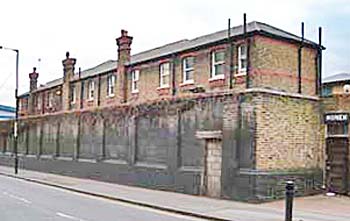
Further up Brooksby's Walk, looking back to the south, the fortress wall of the Homerton Hospital complex can be seen, with the back of Chatsworth House behind.

Looking north along Brooksby's Walk, one can see what appears to be the only surviving wall of the Eastern Hospital.
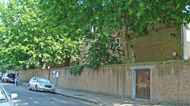
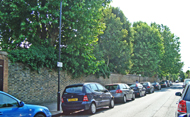
The old wall along Clifden Road, site of the City of London workhouse.
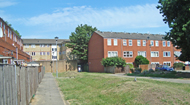

The site of the City of London workhouse northern infirmary is now occupied by new housing (left), while the site of the southern infirmary now contains a children's centre (right).
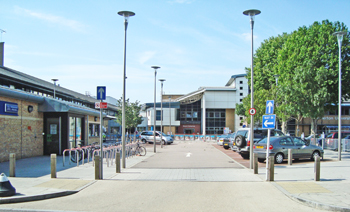
The Homerton Hospital.
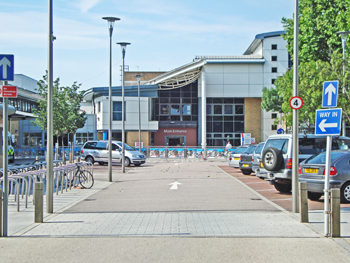
The main entrance of Homerton Hospital.
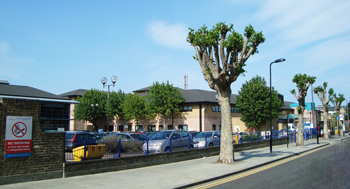
The Homerton Hospital, as seen from the west.
Other 'lost' hospitals in Hackney are the Hackney, Mothers', St. Leonard's and the German, which were replaced by the Homerton Hospital.
Mortimer PP 2008 Ridding London of smallpox: the aerial transmission debate and the evolution of a precautionary approach. Epidemiology & Infection 136, 1297-1305.
www.bartsandthelondon.nhs.uk
www.homerton.nhs.uk (1)
www.homerton.nhs.uk (2)
www.nhshistory.net
www.workhouses.org.uk
www.yeahhackney.com
Return to home page